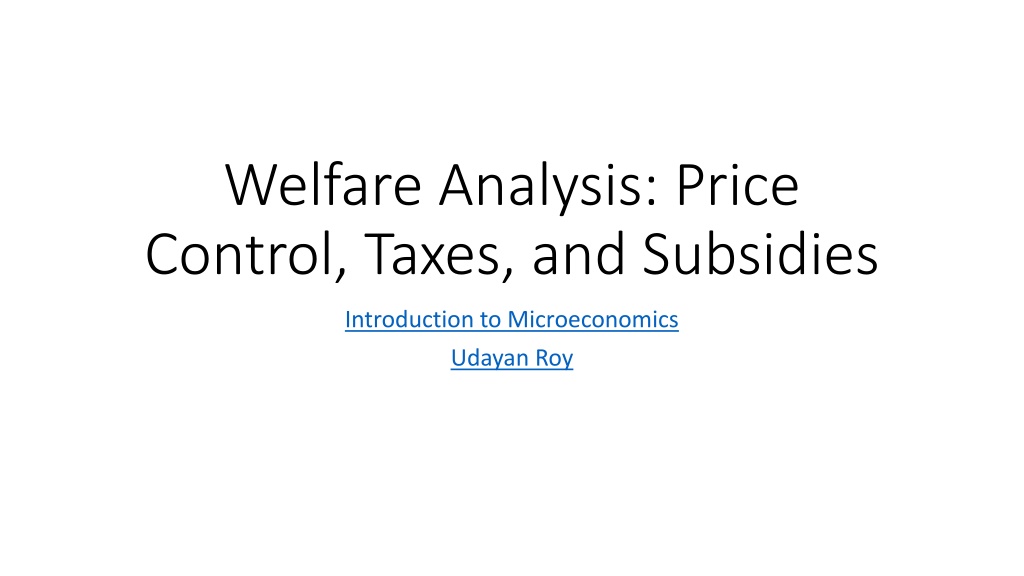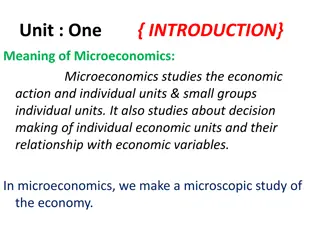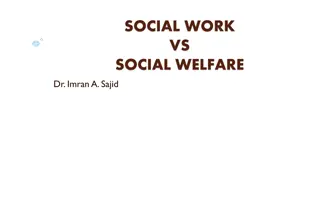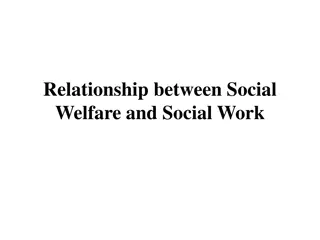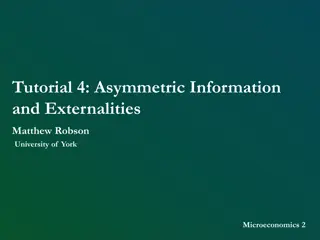Understanding Welfare Analysis in Microeconomics
Explore the impact of price control, taxes, and subsidies on total surplus and welfare in microeconomics. Learn about deadweight loss, government interventions, and the effects of policy decisions on economic outcomes. Gain insights into how quantity deviations from equilibrium affect different stakeholders and overall economic welfare.
Download Presentation

Please find below an Image/Link to download the presentation.
The content on the website is provided AS IS for your information and personal use only. It may not be sold, licensed, or shared on other websites without obtaining consent from the author. Download presentation by click this link. If you encounter any issues during the download, it is possible that the publisher has removed the file from their server.
E N D
Presentation Transcript
Welfare Analysis: Price Control, Taxes, and Subsidies Introduction to Microeconomics Udayan Roy
Sources: Principles of Microeconomics/Economics by N. Gregory Mankiw Chapter 8: Application: The Costs of Taxation 8-1 The Deadweight Loss of Taxation
Sources: Principles of Microeconomics/Economics by Timothy Taylor Chapter 4: Demand and Supply Supply, Demand, and Efficiency Inefficiency of Price Floors and Price Ceilings
Recap: The Graphical Cornerstones of Welfare Analysis
Total Surplus = Benefit Cost Benefit Cost Total Surplus Qeqm Qless Price Supply A B C E D Demand G F Quantity 0 Qeqm Qless
Total Surplus = Benefit Cost Benefit Cost Total Surplus Qeqm Qless ABCDEFG FG ABCDE Price ABDF F ABD Supply A Conclusion: Producing less than the equilibrium output reduces Total Surplus. B C E D The reduction of Total Surplus is called the Deadweight Loss. It is CE in the figure. Demand G F Quantity 0 Qeqm Qless
Total Surplus = Benefit Cost Benefit Cost Total Surplus Qeqm Qless ABCDEFG FG ABCDE Price ABDF F ABD Supply A Conclusion: Producing less than the equilibrium output reduces Total Surplus. B C E D Taxes, price ceilings, and price floors all push the quantity bought and sold below the equilibrium quantity. Consequently, they all reduce Total Surplus. Demand G F Quantity 0 Qeqm Qless
Welfare Analysis of Government Interventions When in an earlier chapter we analyzed the effects of price control and taxes we saw that they all made the quantity bought and sold less than the equilibrium quantity We also saw that each policy intervention was bad for some and good for some But we could not measure how much those who gained gained and how much those who lost lost So, we could not say whether the economy as a whole benefited from these policy interventions or not
Welfare Analysis of Government Interventions But now we can show that the benefits from price control and taxation are always smaller than the costs Every one of these policy interventions ends up reducing the economy s total surplus Every one of these policy interventions ends up having a deadweight loss
Total Surplus = Benefit Cost Benefit Cost Total Surplus Qeqm Qmore Price Supply A B C D Demand G F Quantity 0 Qeqm Qmore
Total Surplus = Benefit Cost Benefit Cost Total Surplus Qeqm Qmore ABDF F ABD Price ABDFG CG ABD C Supply A Conclusion: Producing more than the equilibrium output reduces Total Surplus. E B C The decrease in Total Surplus is called the Deadweight Loss. It is C in the figure. D Demand G F Quantity 0 Qeqm Qmore
Total Surplus = Benefit Cost Benefit Cost Total Surplus Qeqm Qmore ABDF F ABD Price ABDFG CG ABD C Supply A Conclusion: Producing more than the equilibrium output reduces Total Surplus. E B C Subsidies push the quantity bought and sold above the equilibrium quantity. Consequently, subsidies reduce Total Surplus. D Demand G F Quantity 0 Qeqm Qmore
Welfare Analysis of Government Interventions Taxes, price ceilings, and price floors have one thing in common: they all make the quantity bought and sold less than the equilibrium quantity Subsidies make the quantity bought and sold more than the equilibrium quantity In the last chapter, we saw that under perfect competition the equilibrium quantity maximizes total surplus Therefore, under perfect competition all four government interventions end up reducing total surplus
How taxation affects well-being A lesson in how to apply the concepts of consumer surplus and producer surplus to evaluate a government policy
The Effects of Taxation We have seen in an earlier chapter that taxes reduce the equilibrium quantity, increase the price paid by buyers, and decrease the price received by sellers. We have also seen that It does not matter whether a tax is placed on the buyers or the sellers; the outcome is the same in either case But how do taxes affect the economic well-being of market participants?
Welfare Economics Welfare economics is the study of how the allocation ofresources affects economic well-being. We have seen that Buyers benefit from buying (consumer surplus), and Sellers benefit from selling (producer surplus) The equilibrium outcome in a perfectly competitive market maximizes the total surplus of society.
Applying welfare economics to study the effects of taxation In this chapter we will combine what we learned in previous chapters to compare the costs and the benefits of a tax
The Effects of a Tax Buyers Price Sellers price Supply Price buyers pay Size of tax Price without tax Price sellers receive Demand Quantity 0 Quantity with tax Quantity without tax
How a Tax Affects Market Participants A tax places a wedge between the price buyers pay and the price sellers receive. Because of this tax wedge, the quantity sold falls below the level that would be sold without a tax. This fall in output leads to a reduction in Total Surplus
How a Tax Affects Market Participants Governments earn revenue from taxes This revenue is the benefit of the tax Tax Revenue T = the size of the tax Q = the quantity of the good sold T Q= the government s tax revenue
Tax Revenue Price Supply Price buyers Size of tax (T) pay Tax revenue (T Q) Price sellers receive Demand Quantity sold (Q) Quantity 0 Quantity with tax Quantity without tax
How a Tax Affects Welfare Price Supply A Price buyers pay = PB B C Price = P1 without tax E D Price sellers receive = PS F Demand Quantity 0 Q2 Q1
Deadweight Losses and the Gains from Trade The cost of a tax exceeds the benefit of a tax The decrease in total surplus that is caused by a tax is the deadweight loss of the tax Taxes cause deadweight losses because they prevent buyers and sellers from realizing some of the gains from trade.
The Deadweight Loss Price Lost gains from trade Supply PB Size of tax Price without tax PS Cost to sellers Demand Value to buyers Quantity 0 Q2 Q1 Reduction in quantity due to the tax
DETERMINANTS OF THE DEADWEIGHT LOSS What determines whether the deadweight loss from a tax is large or small? The size of the deadweight loss depends on how much the quantity supplied and quantity demanded respond to changes in the price. In other words, the size of a tax s deadweight loss depends on the price elasticities of supply and demand.
Tax Distortions and Elasticities Tax Distortions and Elasticities (a) Inelastic Supply Price Supply When supply is relatively inelastic, the deadweight loss of a tax is small. Size of tax Demand 0 Quantity
Tax Distortions and Elasticities Tax Distortions and Elasticities (b) Elastic Supply Price When supply is relatively elastic, the deadweight loss of a tax is large. Supply Size of tax Demand Quantity 0
Tax Distortions and Elasticities Tax Distortions and Elasticities (c) Inelastic Demand Price Supply Size of tax When demand is relatively inelastic, the deadweight loss of a tax is small. Demand Quantity 0
Tax Distortions and Elasticities Tax Distortions and Elasticities (d) Elastic Demand Price Supply Size of tax Demand When demand is relatively elastic, the deadweight loss of a tax is large. Quantity 0
DETERMINANTS OF THE DEADWEIGHT LOSS Key Idea: The greater the elasticities of demand and supply: the larger the decline in equilibrium quantity and, the greater the deadweight loss of a tax.
The Deadweight Loss Debate Some economists argue that taxes on labor income are highly distorting that is, taxes on labor income have high deadweight losses because they believe that labor supply is elastic. Here are some examples of workers who may respond more to incentives: Workers who can adjust the number of hours they work Families with second earners Elderly who can choose when to retire Workers in the underground economy (i.e., those engaging in illegal activity)
Why then do we have taxes? This chapter has focused on the negative effects of taxes on buyers and sellers in a market However, without taxes we would not have a functioning government As Oliver Wendell Holmes, Jr., Supreme Court Justice, once said, Taxes are the price we pay for a civilized society."
Why then do we have taxes? We may wish to discourage certain activities, such as smoking Government must be paid for Tax revenues may increase fairness, even if it decreases efficiency
How a Price Ceiling Affects Welfare
How a Price Ceiling Affects Welfare Price Supply Equilibrium Price P1 Equilibrium (No Price Ceiling) Demand Q1 Quantity 0 Equilibrium Quantity
How a Price Ceiling Affects Welfare Price Supply Equilibrium Price P1 Equilibrium (No Price Ceiling) Price Ceiling PC Demand QS Q1 Quantity 0 Equilibrium Quantity
How a Price Ceiling Affects Welfare Price Supply A Total Surplus = Buyers Benefit Sellers Cost No Price Ceiling Price Ceiling Change B Equilibrium Price P1 Equilibrium (No Price Ceiling) Buyers Benefit D C Sellers Cost Price Ceiling PC Total Surplus E Demand F G QS Q1 Quantity 0 Equilibrium Quantity
How a Price Ceiling Affects Welfare Price Supply A Total Surplus = Buyers Benefit Sellers Cost No Price Ceiling Price Ceiling Change B Equilibrium Price P1 Equilibrium (No Price Ceiling) Buyers Benefit ABCDEFG ACEF -(B+D+G) D C Sellers Cost FG F -G Price Ceiling PC Total Surplus ABCDE ACE -(B+D) E Demand F G QS Q1 Quantity 0 Equilibrium Quantity
How a Price Ceiling Affects Welfare Price Supply A Total Surplus = Buyers Benefit Sellers Cost No Price Ceiling Price Ceiling Change B Equilibrium Price P1 Equilibrium (No Price Ceiling) Buyers Benefit ABCDEFG ACEF -(B+D+G) D C Sellers Cost FG F -G Price Ceiling PC Total Surplus ABCDE ACE -(B+D) E Key Definition: The deadweight loss of a government policy is the decrease in total surplus caused by the policy. Demand F G QS Q1 Quantity 0 So, the deadweight loss of a price ceiling is B + D. Equilibrium Quantity
Total Surplus = Buyers Benefit Sellers Cost No Price Ceiling Price Ceiling Change How a Price Ceiling Affects Welfare Buyers Benefit ABCDEFG ACEF -(B+D+G) Sellers Cost FG F -G Price Total Surplus ABCDE ACE -(B+D) The bad news is that the price ceiling makes the buyers benefit (or willingness to pay, or happiness) decrease. Supply A B Equilibrium Price Sellers costs also decrease, but not enough to make up for the drop in buyers benefit. P1 Equilibrium (No Price Ceiling) D C Price Ceiling PC E So, total surplus decreases. The deadweight loss of a price ceiling is B + D. Demand F G QS Q1 Quantity 0 Equilibrium Quantity
How a Price Ceiling Affects Welfare Price Supply A Total Surplus = Consumer Surplus + Producer Surplus No Price Ceiling Price Ceiling Change B Equilibrium Price P1 Equilibrium (No Price Ceiling) Consumer Surplus D C Producer Surplus Price Ceiling PC Total Surplus E Demand F G QS Q1 Quantity 0 Equilibrium Quantity
How a Price Ceiling Affects Welfare Price Supply A Total Surplus = Consumer Surplus + Producer Surplus No Price Ceiling Price Ceiling Change B Equilibrium Price P1 Equilibrium (No Price Ceiling) Consumer Surplus AB AC C-B D C Producer Surplus CDE E -(C+D) Price Ceiling PC Total Surplus ABCDE ACE -(B+D) E Key Definition: The deadweight loss of a government policy is the decrease in total surplus caused by the policy. Demand F G QS Q1 Quantity 0 So, the deadweight loss of a price ceiling is B + D. Equilibrium Quantity
Total Surplus = Consumer Surplus + Producer Surplus No Price Ceiling Price Ceiling Change How a Price Ceiling Affects Welfare Consumer Surplus AB AC C-B Producer Surplus CDE E -(C+D) Price Total Surplus ABCDE ACE -(B+D) Producer surplus decreases when the government imposes a price ceiling. Supply A Even though the consumers may have begged the government for a price ceiling, consumer surplus may increase (if C > B) or decrease (if C < B). B Equilibrium Price P1 Equilibrium (No Price Ceiling) D C Price Ceiling PC E Even if consumer surplus increases, the increase will not make up for the decrease in producer surplus. Demand F G QS Q1 Quantity 0 So, total surplus will decrease. The deadweight loss of a price ceiling is B + D. Equilibrium Quantity
How a Price Floor Affects Welfare Price Supply Equilibrium Price P1 Equilibrium (No Price Floor) Demand Q1 Quantity 0 Equilibrium Quantity
How a Price Floor Affects Welfare Price Supply Price Floor PF Equilibrium Price P1 Equilibrium (No Price Floor) Demand QD Q1 Quantity 0 Equilibrium Quantity
How a Price Floor Affects Welfare Price Supply A Price Floor PF Total Surplus = Buyers Benefit Sellers Cost B No Price Floor Price Floor Change C Equilibrium Price P1 Equilibrium (No Price Floor) Buyers Benefit E Sellers Cost D Total Surplus Demand F G QD Q1 Quantity 0 Equilibrium Quantity
How a Price Floor Affects Welfare Price Supply A Price Floor PF Total Surplus = Buyers Benefit Sellers Cost B No Price Floor Price Floor Change C Equilibrium Price P1 Equilibrium (No Price Floor) Buyers Benefit ABCDEFG ABDF -(CEG) E Sellers Cost FG F -G D Total Surplus ABCDE ABD -(CE) Demand F G QD Q1 Quantity 0 Equilibrium Quantity
How a Price Floor Affects Welfare Price Supply A Price Floor PF Total Surplus = Buyers Benefit Sellers Cost B No Price Floor Price Floor Change C Equilibrium Price P1 Equilibrium (No Price Floor) Buyers Benefit ABCDEFG ABDF -(CEG) E Sellers Cost FG F -G D Total Surplus ABCDE ABD -(CE) Key Definition: The deadweight loss of a government policy is the decrease in total surplus caused by the policy. Demand F G QD Q1 Quantity 0 So, the deadweight loss of a price ceiling is C + E. Equilibrium Quantity
Total Surplus = Buyers Benefit Sellers Cost No Price Floor Price Floor Change How a Price Floor Affects Welfare Buyers Benefit ABCDEFG ABDF -(CEG) Sellers Cost FG F -G Price Total Surplus ABCDE ABD -(CE) The bad news about a price floor: buyers benefit decreases. Supply A Price Floor PF The good news about a price floor: Sellers cost also decreases. B C Equilibrium Price P1 Equilibrium (No Price Floor) E But buyers benefit decreases more than sellers cost decreases. D So, overall, total surplus decreases. Demand The deadweight loss of a price ceiling is C + E. F G QD Q1 Quantity 0 Equilibrium Quantity
